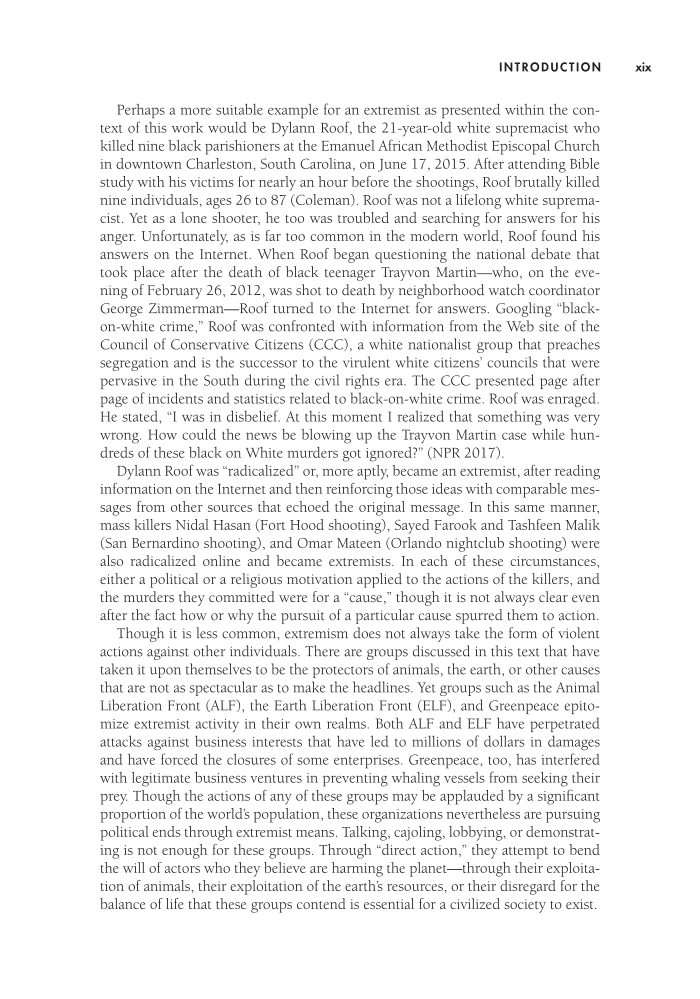xix INTRODUCTION Perhaps a more suitable example for an extremist as presented within the con- text of this work would be Dylann Roof, the 21-year-old white supremacist who killed nine black parishioners at the Emanuel African Methodist Episcopal Church in downtown Charleston, South Carolina, on June 17, 2015. After attending Bible study with his victims for nearly an hour before the shootings, Roof brutally killed nine individuals, ages 26 to 87 (Coleman). Roof was not a lifelong white suprema- cist. Yet as a lone shooter, he too was troubled and searching for answers for his anger. Unfortunately, as is far too common in the modern world, Roof found his answers on the Internet. When Roof began questioning the national debate that took place after the death of black teenager Trayvon Martin—who, on the eve- ning of February 26, 2012, was shot to death by neighborhood watch coordinator George Zimmerman—Roof turned to the Internet for answers. Googling “black- on-white crime,” Roof was confronted with information from the Web site of the Council of Conservative Citizens (CCC), a white nationalist group that preaches segregation and is the successor to the virulent white citizens’ councils that were pervasive in the South during the civil rights era. The CCC presented page after page of incidents and statistics related to black-on-white crime. Roof was enraged. He stated, “I was in disbelief. At this moment I realized that something was very wrong. How could the news be blowing up the Trayvon Martin case while hun- dreds of these black on White murders got ignored?” (NPR 2017). Dylann Roof was “radicalized” or, more aptly, became an extremist, after reading information on the Internet and then reinforcing those ideas with comparable mes- sages from other sources that echoed the original message. In this same manner, mass killers Nidal Hasan (Fort Hood shooting), Sayed Farook and Tashfeen Malik (San Bernardino shooting), and Omar Mateen (Orlando nightclub shooting) were also radicalized online and became extremists. In each of these circumstances, either a political or a religious motivation applied to the actions of the killers, and the murders they committed were for a “cause,” though it is not always clear even after the fact how or why the pursuit of a particular cause spurred them to action. Though it is less common, extremism does not always take the form of violent actions against other individuals. There are groups discussed in this text that have taken it upon themselves to be the protectors of animals, the earth, or other causes that are not as spectacular as to make the headlines. Yet groups such as the Animal Liberation Front (ALF), the Earth Liberation Front (ELF), and Greenpeace epito- mize extremist activity in their own realms. Both ALF and ELF have perpetrated attacks against business interests that have led to millions of dollars in damages and have forced the closures of some enterprises. Greenpeace, too, has interfered with legitimate business ventures in preventing whaling vessels from seeking their prey. Though the actions of any of these groups may be applauded by a significant proportion of the world’s population, these organizations nevertheless are pursuing political ends through extremist means. Talking, cajoling, lobbying, or demonstrat- ing is not enough for these groups. Through “direct action,” they attempt to bend the will of actors who they believe are harming the planet—through their exploita- tion of animals, their exploitation of the earth’s resources, or their disregard for the balance of life that these groups contend is essential for a civilized society to exist.
Document Details My Account Print multiple pages
Print
You have printed 0 times in the last 24 hours.
Your print count will reset on at .
You may print 0 more time(s) before then.
You may print a maximum of 0 pages at a time.


















































































































































































































































































































































































































































































